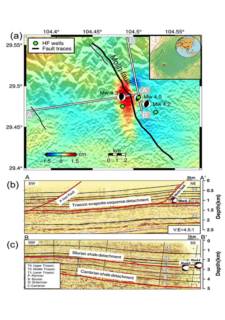|
||||||||||||||||
|
||||||||||||||||
|
| |||
| 27. 10. 2020 | Issue 70 | ||
|
| |||
| Probing Deep into Shallow Earthquakes Induced by Shale Gas Production in Sichuan | |
|
Professor Yang Hong Feng of Earth System Science Programme conducted a comprehensive study of the 2019 Weiyuan Earthquake Sequences in Sichuan, China and revealed that the extremely shallow earthquake occurred in February of the same year is related to the shale gas production nearby.
Since 2012, shale gas production has been rapidly developed in the Sichuan basin to extract oil and gas; hydraulic fracturing, also termed fracking, is a commonly used technique to increase the permeability within the reservoir by injecting high-pressure fluid to create fractures in rocks. On 25 February, 2019, an earthquake with local magnitude of 4.9 struck Rong County; around 20 and 4.5 hours before the quake, two foreshocks with magnitudes larger than 4 also occurred nearby. Professor Yang and his team studied the earthquake sequence in Weiyuan Shale Gas Field and revealed that the two earthquakes were induced by fracking as it increased pore pressure on the fault and led to fault slip.
They also found that the main shock was constrained to a much shallower depth of 1 kilometer. The very shallow portion of fault in general does not bring about earthquakes but the Molin fault triggering the 4.9-magnitude earthquake is an exception, marking a rare record of extremely shallow rupture. With the high and emerging demand for energy resources, it is likely that fracking will continue and be intensified in the Sichuan basin, posing risk to seismic hazards. Their new findings help advance our understanding of earthquake physics and raise our awareness towards a secure and sustainable development of the shale gas industry.
Further Reading:
Wang, M., Yang, H., Fang, L., Han, L., Jia, D., Jiang, D., & Yan, B. (2020). Shallow Faults Reactivated by Hydraulic Fracturing: The 2019 Weiyuan Earthquake Sequences in Sichuan, China. Seismological Research Letters. DOI: https://doi.org/10.1785/0220200174
|
|
| Back to Issue | |
|
Past Issue
| |
|
|
|
|
|
Copyright ©
2025. All Rights Reserved. Faculty of Science, The Chinese University of Hong Kong.












